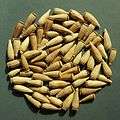Papaver dubium
| Papaver dubium | |
|---|---|
 | |
| Papaver dubium and P. radicatum | |
| Scientific classification | |
| Kingdom: | Plantae |
| (unranked): | Angiosperms |
| (unranked): | Eudicots |
| Order: | Ranunculales |
| Family: | Papaveraceae |
| Genus: | Papaver |
| Species: | P. dubium |
| Binomial name | |
| Papaver dubium L. | |
Papaver dubium is a species of poppy known by the common names long-headed poppy and blindeyes. It is a very undemanding species which prefers sandy soils without lime. It is widespread throughout Europe and America.[1]
Description
Papaver dubium is a variable annual, growing to about 60cm in height. It generally flowers in late spring to mid-summer. The flower is large (30-70mm)[2] and showy, with four petals that are lighter red than in the similar Papaver rhoeas, and most commonly without a black spot at the base. The flower stem is usually covered with coarse hairs that are closely appressed to the surface, helping to distinguish it from P. rhoeas in which the hairs are more usually patent, held at right angles to the stem. The capsules are hairless, elongated to more than twice as tall as they are wide, tapering slightly at the tip, with a stigma generally less wide than the capsule. The plant exudes white to yellowish latex when the tissues are broken.[3] The species can form a long-lived soil seed bank that can germinate when the soil is disturbed.
Gallery
 White-flower variety
White-flower variety Flower
Flower Fruit
Fruit Illustration
Illustration Capsules
Capsules
References
- ↑ "PLANTS Profile at USDA". Retrieved 2012-01-07.
- ↑ Blamey, M.; Fitter, R.; Fitter, A (2003). Wild flowers of Britain and Ireland: The Complete Guide to the British and Irish Flora. London: A & C Black. p. 32. ISBN 978-1408179505.
- ↑ Stace, C.A. (2010). New flora of the British isles (Third ed.). Cambridge, U.K.: Cambridge University Press. p. 88. ISBN 9780521707725.
External links
| Wikimedia Commons has media related to Papaver dubium. |
| Wikispecies has information related to: Papaver dubium |